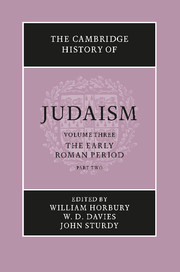Book contents
- Frontmatter
- 1 The archaeology of Palestine 63 bce–ce 70
- 2 The Herodian Temple
- 3 Recent archaeology in Palestine: achievements and future goals
- 4 The contribution of Jewish inscriptions to the study of Judaism
- 5 The social, economic and political history of Palestine 63 bce–ce 70
- 6 The Diaspora in the Roman period before ce 70
- 7 The Gentiles in Judaism 125 bce–ce 66
- 8 Gentiles as seen by Jews after ce 70
- 9 The synagogue
- 10 The Temple and the synagogue
- 11 The early liturgy of the synagogue
- 12 Women in the synagogue
- 13 The Pharisees
- 14 The Sadducees – their history and doctrines
- 15 The Essenes
- 16 The baptist sects
- 17 The troublemakers
- 18 The Samaritans and their sects
- 19 Galilean Judaism and Judaean Judaism
- 20 Jesus: from the Jewish point of view
- 21 Paul: from the Jewish point of view
- 22 Jewish Christianity
- 23 Apocalyptic: the disclosure of heavenly knowledge
- 24 The Qumran sectarian writings
- 25 The Dead Sea Scrolls and pre-Tannaitic Judaism
- 26 Prayer in the Qumran Texts
- 27 Philo of Alexandria
- 28 Josephus (ce 37–c. 100)
- 29 The rabbi in second-century Jewish society
- 30 The Hellenistic–Roman Diaspora ce 70–ce 235: the archaeological evidence
- 31 The legacy of Egypt in Judaism
- 32 Jewish elements in gnosticism and magic c.ce 70–c.ce 270
- Bibliographies
- Index
- References
7 - The Gentiles in Judaism 125 bce–ce 66
Published online by Cambridge University Press: 28 March 2008
- Frontmatter
- 1 The archaeology of Palestine 63 bce–ce 70
- 2 The Herodian Temple
- 3 Recent archaeology in Palestine: achievements and future goals
- 4 The contribution of Jewish inscriptions to the study of Judaism
- 5 The social, economic and political history of Palestine 63 bce–ce 70
- 6 The Diaspora in the Roman period before ce 70
- 7 The Gentiles in Judaism 125 bce–ce 66
- 8 Gentiles as seen by Jews after ce 70
- 9 The synagogue
- 10 The Temple and the synagogue
- 11 The early liturgy of the synagogue
- 12 Women in the synagogue
- 13 The Pharisees
- 14 The Sadducees – their history and doctrines
- 15 The Essenes
- 16 The baptist sects
- 17 The troublemakers
- 18 The Samaritans and their sects
- 19 Galilean Judaism and Judaean Judaism
- 20 Jesus: from the Jewish point of view
- 21 Paul: from the Jewish point of view
- 22 Jewish Christianity
- 23 Apocalyptic: the disclosure of heavenly knowledge
- 24 The Qumran sectarian writings
- 25 The Dead Sea Scrolls and pre-Tannaitic Judaism
- 26 Prayer in the Qumran Texts
- 27 Philo of Alexandria
- 28 Josephus (ce 37–c. 100)
- 29 The rabbi in second-century Jewish society
- 30 The Hellenistic–Roman Diaspora ce 70–ce 235: the archaeological evidence
- 31 The legacy of Egypt in Judaism
- 32 Jewish elements in gnosticism and magic c.ce 70–c.ce 270
- Bibliographies
- Index
- References
Summary
‘JEWS’ AND ‘GENTILES’: TERMINOLOGY
By Hasmonaean times the people of Palestine had survived and been increased by two thousand years of invasions. The Israelite invasion had been only one in a long series. The series had produced a stock of untraceable complexity, diversified by many small groups with recognizable local characteristics. Such groups were more conspicuous than the population's general uniformity, hence classical Hebrew had no word equivalent to our ‘Palestinian’; Pelishtim means ‘Philistines’, another peculiar group of invaders. ‘Canaanite’ was sometimes pressed into service for the whole non-Israelite population, but properly speaking the Canaanites were only one of the many little peoples whom the Israelites had found living in the land. According to the stories of the Israelite invasion they had shared possession with Perizzites, Hivites, Amorites, Jebusites, etc.
Such peoples the Israelites called ‘the goyyim’. Goy (the singular) refers to ‘an ethnic group considered as a political rather than a biological entity’; it was therefore rendered by the King James translators as ‘nation’. In this sense it was occasionally used for ‘Israel’ (the Israelites considered as a single group). More frequently, however, goy and goyyim were used of non-Israelite groups, often by antithesis to Israel, and pejoratively. Both singular and plural referred to ‘nations’ only; the classical Hebrew terms for a single alien, qua alien, were nokhri and zar. There was no term whatever for an individual who worshipped gods other than Yahweh, much less for all such persons. It was taken for granted that other nations worshipped their own gods (though individuals among them might also worship Yahweh), but until the end of the monarchy the Israelites thought of aliens primarily as strangers and as members of other nations, not as worshippers of other gods; there was no term for, nor concept of, ‘the heathen’ as such.
- Type
- Chapter
- Information
- The Cambridge History of Judaism , pp. 192 - 249Publisher: Cambridge University PressPrint publication year: 1999
References
- 2
- Cited by



